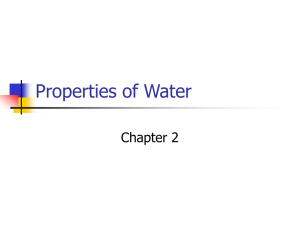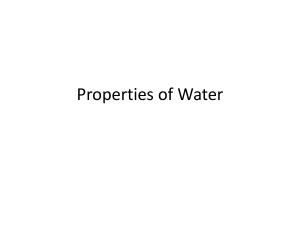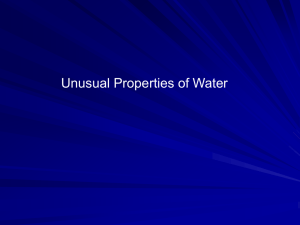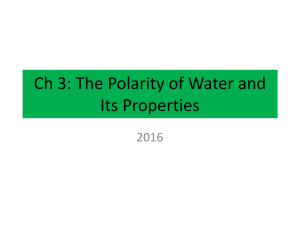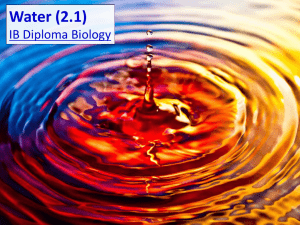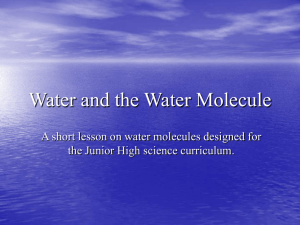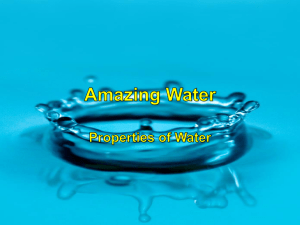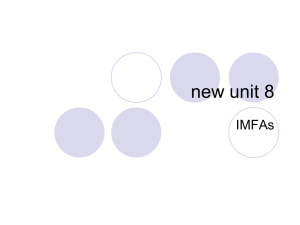Properties of Water Important to Life
advertisement
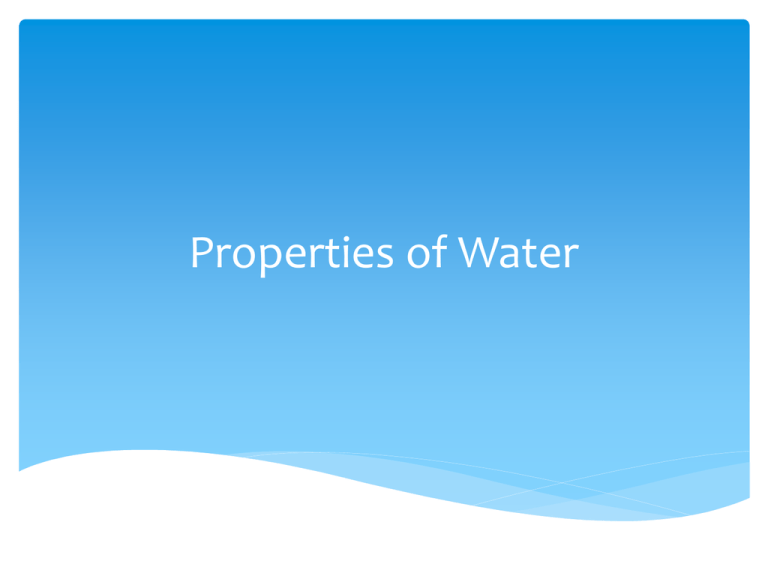
Properties of Water Directions Read information about the properties of water and carry out the experiments using the materials at your lab station. Answer all numbered questions in red on a separate piece of paper. Make sure that paper has a proper heading. Vocabulary Polar bond Hydrogen bond Cohesion Surface tension Adhesion Specific heat Density Solution Solvent Solute pH Acid Base Part I: Structure of Water Write this heading on your paper and then answer all of the questions for this section under that heading! Structure of Water (–) This is the structural formula of water. A. Draw a picture of water. B. What is the chemical formula of water? (–) O H (+) H (+) Structure of Water ACTIVITY Build a water molecule using the molecular model pieces in the box. (blue is O and white is H) Structure of Water (–) (–) • The Hydrogen and Oxygen in water are bonded covalently. O H (+) • HINT: definition of covalent! H (+) C. How many electrons are shared to form a covalent bond? D. Why does oxygen form 2 bonds and hydrogen form one bond? Structure of Water (–) (–) However, as the atoms share their electrons they do not do so evenly. O H (+) E. Which atom is larger? O or H? The oxygen in water hogs the electrons and is therefore slightly negative. H (+) This results in the two hydrogen atoms becoming slightly positive. Add the + and – charges to your picture in A. Structure of Water (–) (–) Water is POLAR. Hint: what is polarity? Polarity contributes to emergent properties of water O H H Batteries have a + and – pole! (+) (+) F. What is polarity? G. Why is water considered polar? Earth has a north and south pole! Hydrogen Bonds One water molecule tends to bond to another water molecule by hydrogen bonding. (–) Hydrogen bond The H+ on one molecule is attracted to the O- of another. (+) H O (+) (–) H (–) (+) (–) (+) Each water molecule can form a max. of 4 hydrogen bonds with 4 other water molecules A single hydrogen bond is weaker than a single covalent bond. However, groups of hydrogen bonds are very strong Responsible for the “stickiness” of water molecules H. Why do hydrogen bonds form between water molecules? I. Draw 4 water molecules connected by hydrogen bonds. Part II: Water is the Universal Solvent Write this heading on your paper and then answer all of the questions for this section under that heading! Water is the ‘universal solvent’ Solution = liquid consisting of uniform mixture of two or more substances Two parts of a solution: Solvent = liquid (dissolving agent) Solute = substance dissolved (EX: Water = solvent; Koolaid powder/sugar = solutes; Kool-aid = solution) To make a solution you need to remember the rule - “like dissolves like” Since water is polar it will dissolve ions and polar substances Since water is polar it will NOT dissolve anything nonpolar Non polar molecules are hydrophobic Oil is an example of a nonpolar molecule. It does not form hydrogen bonds. Like dissolves like, therefore, oil (nonpolar) does not dissolve in water (polar). Nonpolar molecules are called hydrophobic or 'water hating’ because they do not mix with water. A. Briefly explain what a solution is and its parts. B. You make instant coffee in the morning by adding a tablespoon of coffee to a hot cup of water. Label the solution, solute and solvent in this scenario. C. Why doesn’t oil and water mix? ACTIVITY Using the pipettes provided add 2ml of water to a test tube. Gently add 2 ml of cooking oil to the same tube by tilting the test tube of water slightly and letting the oil run slowly down the inside of the test tube. D. Describe what happened. ACTIVITY Using the pipettes provided add 2ml of cooking oil to a DIFFERENT test tube. Gently add 2 ml of water to the same tube by tilting the test tube of oil slightly and letting the water run slowly down the inside of the test tube. E. Describe what happened. ACTIVITY Add a few drops of food coloring to each test tube. Place your finger over the test tube and gently shake to mix the oil and water. F. How does the food coloring act in each test tube? Does it mix into the oil? Into the water? G. Explain why water molecules and oil molecules separate from each other. Your explanation should discuss polar and non-polar molecules, and the effects of polarity on the interactions between water molecules, and hydrogen bonding. Part III: Cohesion and Adhesion Write this heading on your paper and then answer all of the questions for this section under that heading! COHESION Water molecules 'stick to each other' (due to hydrogen bonding) Makes water act as if it has invisible “skin” Called SURFACE TENSION (how difficult it is to break surface) A. define cohesion See the ‘skin’ of the water AKA surface tension! ACTIVITY Fill the top of a penny with water until a clear bubble has formed on top but it is NOT overflowing. B. Can you can float a needle on the water drop on your penny? C. What property of water allows you to do this? ACTIVITY Dry off your penny. With your finger, spread one small drop of detergent on the surface of a dry penny. Fill the top of a penny again with water until a clear bubble has formed on top but it is NOT overflowing. D. Could this penny hold more, less or the same amount of water? E. Did the detergent make a difference? Describe the effect of the detergent. ADHESION Water molecules stick to other substances Makes water cling to the sides of a cylinder. F. Define adhesion. ACTIVITY What will be the shape of a drop of water on (a) a piece of wax paper and (b) a glass slide? Perform the experiment. Place several drops of water on the glass slide and several drops on the wax paper. G. Draw (and label) the results. H. Explain the differences in drop shape in terms of adhesion - that is, the formation (or absence) of hydrogen bonds between molecules of different types. CAPILLARY ACTION movement of liquid through a narrow passage or substance Result of cohesion of water molecules to each other and adhesion to another surface Makes water ‘travel’ Capillary Action Water is pulled to the top of redwood trees as it evaporates from leaves at the top of the tree. ACTIVITY Obtain a graduated cylinder and a strip of chromatography paper that is just long enough to hang over the side of the cylinder (inside) and reach to the bottom. Place a single small drop of ink from a black vis-a-vis pen on the paper, about one inch from the bottom, and let it dry completely. Put 30 ml of water into the graduated cylinder and place the strip of paper in the cylinder so that the bottom end is in water (just barely). Fold the paper over the top side. Use a paper clip to hold it to the edge. I. Note the starting time in your notebook. Watch and note the time at 5 minute intervals. When the water climbs to the top of the paper, remove the paper from the water, and let it dry. Record how long it took for the water to reach the top. (NOTE: go on to other experiments while you are waiting!) J. In your notes: Describe what you see on the strip of paper. Draw the strip, and label each color on the strip. Part IV: Specific Heat Write this heading on your paper and then answer all of the questions for this section under that heading! HIGH SPECIFIC HEAT - amount of heat a substance needs for a given increase of temperature Takes a lot of energy to raise 1 g of water by 1° C because you must break Hydrogen bonds So… Liquid H2O can absorb large amounts of heat with small changes in temperature So… It heats up more slowly and retains heat longer than surroundings This is important for many reason – for instance in organisms it helps us maintain a constant temperature (homeostasis) HIGH HEAT OF VAPORIZATION Takes a lot of energy to convert liquid H2O into vapor (hydrogen bonding-restricts movement) Vaporization (evaporation) is the change from liquid to gas; Molecules of liquid escape and enter air Evaporation of water produces cooling effect Again this is important for many reasons – for instance in some organisms sweat/pant to cool off when hot (evaporative cooling) ACTIVITY Click this link and complete the exercise. Changing Matter A. As you do describe what happens to the water molecules as you melt the ice cube. B. Why does the graph level off during freezing/melting and then again during condenses/boils? C. What property of water makes it able to absorb a great deal of energy before it changes from solid to liquid to gas? (Hint: what has to break to release water molecules from each other?) Water expands when it freezes (one of few substances that does this) SO . . . ICE IS LESS DENSE THAN LIQUID WATER Hydrogen bonds keep molecules “at arm’s length” when freezing so ice floats Again this is important for many reasons – for instance it insulates bodies of water. Lakes freeze from top down; allowing living things to survive in winter when the lake freezes Water Alcohol This blue ice cube floats in water because ice is less dense than liquid water. The blue ice cube sinks in alcohol because ice has a greater density than alcohol. D. Describe the structure of ice vs. liquid water and explain why ice is less dense than water. See this link for help: Why does ice float? Review If you have time watch this quick video to review the PPT. Make sure to use headphones! http://www.youtube.com/watch_popup?v=Jh2qpsZe6 GA#t=32 http://www.youtube.com/watch?v=DVCYlST6mYQ

